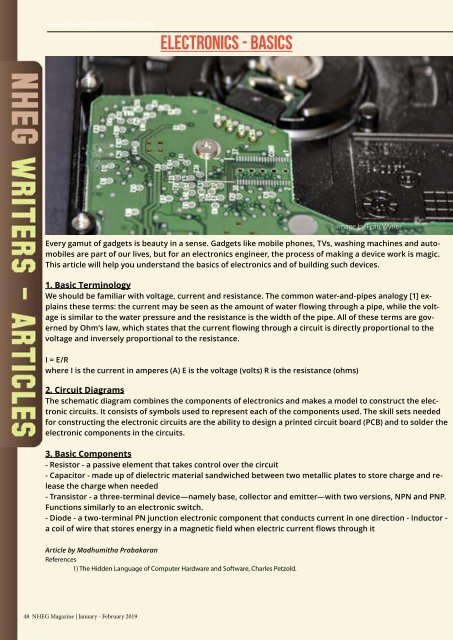NHEG-Magazine-January-February
Create successful ePaper yourself
Turn your PDF publications into a flip-book with our unique Google optimized e-Paper software.
www.NewHeightsEducation.org<br />
Electronics - Basics<br />
The Importance of Safety - Part i<br />
www.NewHeightsEducation.org<br />
Are you thinking about travelling abroad to visit a new place? Exploring new locations is always fun and<br />
enjoyable no matter whether you’re by yourself or with someone else. However, having fun shouldn’t be<br />
your only concern once you reach the destination. The importance of safety should always be a concern for<br />
individuals who like to travel.<br />
Here are some advices on how to be safe when you’re travelling and visiting new places.<br />
Image by Fran Wyner<br />
Every gamut of gadgets is beauty in a sense. Gadgets like mobile phones, TVs, washing machines and automobiles<br />
are part of our lives, but for an electronics engineer, the process of making a device work is magic.<br />
This article will help you understand the basics of electronics and of building such devices.<br />
1. Basic Terminology<br />
We should be familiar with voltage, current and resistance. The common water-and-pipes analogy [1] explains<br />
these terms: the current may be seen as the amount of water flowing through a pipe, while the voltage<br />
is similar to the water pressure and the resistance is the width of the pipe. All of these terms are governed<br />
by Ohm’s law, which states that the current flowing through a circuit is directly proportional to the<br />
voltage and inversely proportional to the resistance.<br />
I = E/R<br />
where I is the current in amperes (A) E is the voltage (volts) R is the resistance (ohms)<br />
2. Circuit Diagrams<br />
The schematic diagram combines the components of electronics and makes a model to construct the electronic<br />
circuits. It consists of symbols used to represent each of the components used. The skill sets needed<br />
for constructing the electronic circuits are the ability to design a printed circuit board (PCB) and to solder the<br />
electronic components in the circuits.<br />
3. Basic Components<br />
- Resistor - a passive element that takes control over the circuit<br />
- Capacitor - made up of dielectric material sandwiched between two metallic plates to store charge and release<br />
the charge when needed<br />
- Transistor - a three-terminal device—namely base, collector and emitter—with two versions, NPN and PNP.<br />
Functions similarly to an electronic switch.<br />
- Diode - a two-terminal PN junction electronic component that conducts current in one direction - Inductor -<br />
a coil of wire that stores energy in a magnetic field when electric current flows through it<br />
Article by Madhumitha Prabakaran<br />
References<br />
1) The Hidden Language of Computer Hardware and Software, Charles Petzold.<br />
48 <strong>NHEG</strong> <strong>Magazine</strong> | <strong>January</strong> - <strong>February</strong> 2019<br />
Image by Khrista Cendana<br />
Are you thinking about travelling abroad to visit a new place? Exploring new locations is always fun and<br />
enjoyable no matter whether you’re by yourself or with someone else. However, having fun shouldn’t be<br />
your only concern once you reach the destination. The importance of safety should always be a concern for<br />
individuals who like to travel.<br />
Here are some advices on how to be safe when you’re travelling and visiting new places.<br />
1) Always Be Mindful About The People Around You<br />
2) Watch Your Belongings Wherever You Go<br />
Don’t always assume that the place you’ll be staying is a safe place. Check the internet or listen to what the<br />
employees of the hotel say. Example: Barcelona - there’re so many pickpockets there that you HAVE to be<br />
EXTRA careful on who you befriend.<br />
3) Don’t Leave Your Belongings Unattended<br />
4) TSA Padlock<br />
Use TSA locks so that you don’t have to worry about the TSA breaking your suitcase lock. The locks vary in<br />
price, $6-$30+, depending on where you buy them.<br />
These advices come from personal experience as I don’t want anyone to go through what happened to my<br />
family and me.<br />
Barcelona, Spain, is one of the busiest tourist spots in the world. Are you thinking about going there? If<br />
you are, there is one place that I would advise you to be extra cautious, and that place is Las Ramblas. Las<br />
Ramblas is somewhat like a marketplace, and as thousands of tourists visit, it is also a thriving ground for<br />
thieves.<br />
Pickpockets aka thieves are not like ordinary thieves. They dress like tourists, and when you’re distracted, the<br />
thieves will snatch away your belongings. While my family and I were eating at Burger King at Las Ramblas<br />
market, my dad sat at the table while my mom and I went to the restroom. The three of us left our bags on an<br />
empty chair at our table, but when we came back to the table, my dad’s bag was missing. He thought we took<br />
it with us. When he figured out that it wasn’t the case, we called for the manager. I thought that it was one of<br />
the people who distracted us, but I had no proof. There was no CCTV, and nobody saw anything. We were told<br />
to report it and to go to the consulate. There, we meet other Americans who were there for the same reason.<br />
Dealing with the aftermath of the pickpocketing made us lose two days of tour. It was an experience that I<br />
never want to repeat.<br />
<strong>January</strong> - <strong>February</strong> 2019 | <strong>NHEG</strong> <strong>Magazine</strong> 49


















